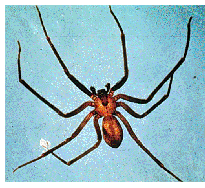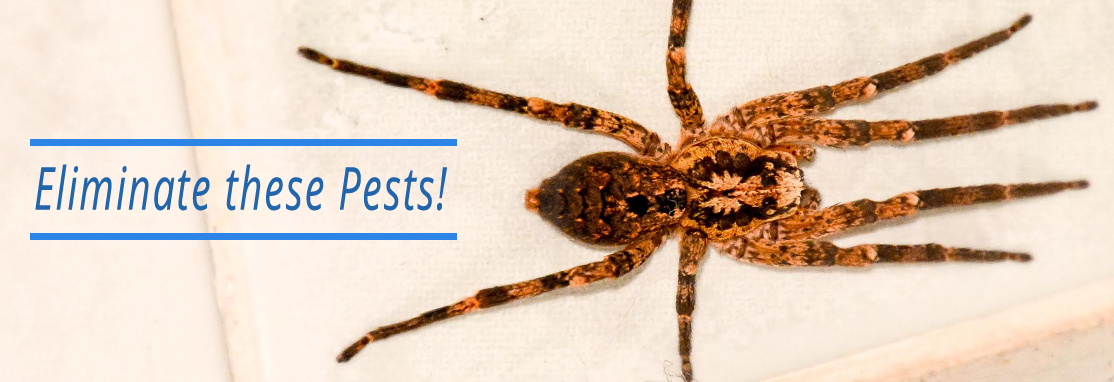Brown Recluse Spider
Araneae: Loxascelidae, Loxosceles reclusa

Brown recluse spiders belong to a group of spiders commonly known as violin spiders or fiddle backs. This is because of a characteristic fiddle-shaped pattern they have on their head region. The spider is golden brown with the fiddle being dark brown or black. This spider is not hairy and the fiddle pattern is often shiny. They are about 1/4 to 3/4 inch long.
Members of this small family are known for their poisonous venom. They have six eyes in three pairs. The cephalothorax is rather flat above and has a conspicuous, lengthwise furrow in the midline at the rear third. Each foot has two claws. Many wolf spiders are similar in appearance and have similar markings as the brown recluse. However, wolf spiders are large, robust, hairy, and therefore they can be distinguished from the brown recluse.
Brown recluse spiders spin small, irregular webs under bark, stones or other secluded areas. Their venom is especially poisonous to people; those bitten often become ill and find that the wound does not heal quickly. Both male and female recluse spiders, as well as their spiderlings, are capable of injecting venom which may result in serious lesion formation or systemic reactions. The severity of the bite may vary. The symptoms may vary from no harm at all to a reaction that is quite severe. Usually, the brown recluse spider bite is not felt and the pain sets in from six to eight hours later. A typical bite area may resemble a pimple, postule or blister formation within six to 12 hours later. Mild to severe pain accompanied by swelling may occur during this interval. The surrounding tissue begins to darken, is irregular in shape with sharply raised edges resulting in a sunken area which may be several centimeters in diameter. Often there is a systemic reaction within 24-36 hours characterized by restlessness, fever, chills, nausea, weakness, and joint pain. Where the bite occurs there is often tissue death and skin is sloughed off. In some severe cases, a wound may develop that lasts several months. In all cases, a physician should be notified. If at all possible, kill and take the spider to the physician for positive identification. Individual spiders can be crushed underfoot or sprayed with an aerosol spray.
Brown recluse spiders are found primarily in the Midwest. Many cases of bites are reported from Alabama, Florida, Georgia, Texas, Kansas, Missouri, and Oklahoma. They are suspected of being in other states as well. The edge of its range just reaches the tip of western Virginia. The spider commonly lives in basements, attics and garages of houses and often hides behind boards and boxes. Bites often occur when the spiders hide in towels or old clothes left in those areas. The brown recluse has adapted quite well to indoor habitats. They are commonly found in the storage areas of residences, including areas such as attics, closets, bedrooms and other dark recesses. This spider frequently inhabits clothing, toys, books, boxes, furniture as well as transport trucks, tool sheds, tree houses and little used or abandoned dog houses.
Brown recluse spiders are nocturnal and prefer foods such as firebrats, crickets, cockroaches and other soft bodied creatures. Earning their name well, the recluse spider ceases its wanderings at first light. People are most commonly bitten in bed, while changing clothes, or cleaning storage areas. Not only will this spider hide in cracks and crevices of the home, they will also often climb into clothing or shoes that someone has laid out to wear the following day.
The female brown recluse spider deposits eggs in off-white silken cases about one-third inch in diameter in sheltered, dark areas. Spiderlings emerge in 24-36 days and abandon the egg case. Development is slow, influenced by weather conditions and food availability. They reach maturity in 10 to 12 months and can survive long periods of time without food or water. Immature spiderlings resemble adult brown recluse spiders but have lighter coloration. Adult males and females will vary from light tan to dark brown.
For methods to eliminate and control brown recluse spiders, please call Regional Pest Management today at 1-800-36-5-STAR.





